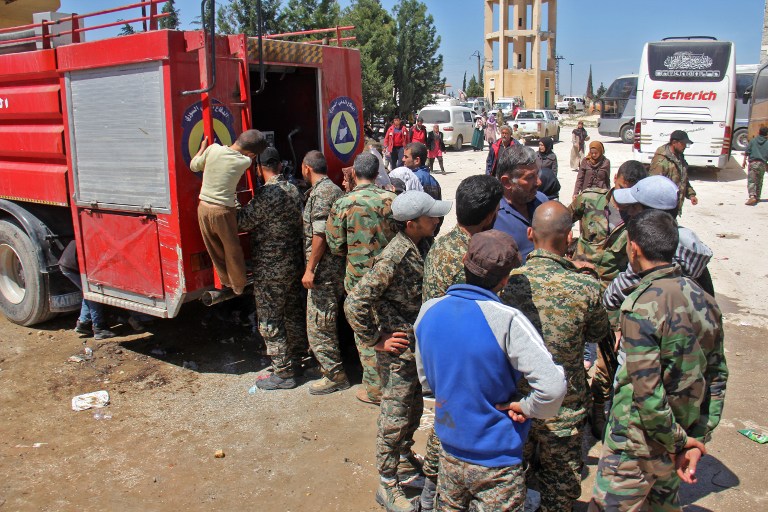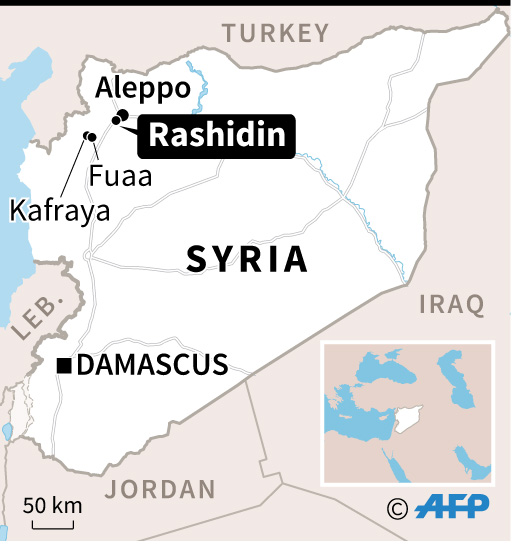
by Omar Haj Kadour
Agence France-Presse
RACHIDINE, Syria – Hundreds of frightened Syrians being evacuated from besieged towns were stuck Thursday at a rebel-held transit point where dozens of their fellow townspeople were killed in a weekend bombing.
The 3,000 evacuees left their homes in the government-controlled towns of Fuaa and Kafraya at dawn on Wednesday as part of a deal under which residents and fighters are also to be evacuated from several rebel areas surrounded by government forces.
The evacuations began last week but were delayed after Saturday’s suicide car bombing that killed 126 people, 68 of them children, at the transit point in Rashidin, west of Aleppo.
The process resumed on Wednesday but evacuees were forced to spend the night at the marshalling area following another delay.
“We are very tired. We’ve been given water, bread and cheese but there are no toilets,” said Abu Nidal, the director of the last makeshift hospital in rebel-held Zabadani. “Most people spent the night on the bus.”
The Syrian Observatory for Human Rights said the latest hold-up was the result of an 11th-hour rebel demand for the release of prisoners held by President Bashar al-Assad’s government.
“The convoys will not move until after the release of 750 prisoners — men and women — from regime prisons and their arrival in rebel-held areas,” the British-based monitoring group said.

Guarded by armed rebels
On Thursday, an AFP correspondent saw the evacuees gathered at the transit point, surrounded by armed rebels. Children played near the waiting buses.
“We left because of the siege and the rockets,” said Umm Sanad, a 50-year-old from Fuaa, who left along her sons aged 15 and 17.
“We left even though we were afraid after the attack,” she said.
Rebel fighters kept all other cars away from the area, except for a Red Crescent vehicle that was allowed to distribute aid.
Saturday’s attack was one of the deadliest since the start of Syria’s six-year civil war and was widely condemned for targeting civilians.
“Someone pretending even to distribute aid and attracting the children produced that horrific explosion,” UN Syria envoy Staffan de Mistura told reporters in Geneva.
No group has claimed responsibility for the blast. The government blamed “terrorists” — a catch-all term for its opponents.
The current evacuations mark the end of the first stage of a deal brokered by regime ally Iran and Qatar, a longtime supporter of Syrian rebel groups.
Shiite-dominated Iran has repeatedly raised concerns for the mainly Shiite residents of Fuaa and Kafraya, who are besieged by Sunni rebels and Islamists who control the surrounding Idlib province.
Under the agreement, residents and rebel fighters are being evacuated from the towns of Madaya, Zabadani, and other nearby opposition-held areas close to Damascus.
On Wednesday, 11 buses carrying around 300 people left Zabadani and two other rebel-held areas around Damascus.
They were being held up on Thursday at a staging point at Ramussa in government-held territory, the Observatory said.
When the current phase of evacuations is complete, a total of 8,000 people should have left Fuaa and Kafraya in exchange for 2,500 civilians and rebels from opposition areas.
Sarin used in attack: watchdog
A second phase of the evacuations — which in total will see up to 30,000 people transferred from their homes — is to begin in June.
Assad’s regime has presented evacuation deals as the best way to end Syria’s war, which has killed more than 320,000 people and forced more than half the population from their homes.
The opposition says the evacuations amount to forced relocation after years of bombardment and siege.
Syria’s opposition and Western leaders have accused Assad’s regime of a wide range of abuses during the conflict, including a suspected chemical attack on the rebel-held town of Khan Sheikhun earlier this month that killed at least 87 people.
A global arms watchdog said Wednesday that “incontrovertible” test results showed that victims in Khan Sheikhun had been exposed to a toxic substance.
Samples from 10 victims of the April 4 attack analysed at laboratories “indicate exposure to sarin or a sarin-like substance,” said Ahmet Uzumcu, head of the Organisation for the Prohibition of Chemical Weapons.
A few days after the incident, US forces carried out a missile strike on a Syrian airbase from where Washington claimed the chemical attack was launched, in the first direct American action against Assad’s regime.
Rebel supporter Washington and regime backer Moscow have been key foreign powers shaping the UN’s Syria peace process.
Mistura said Thursday he would meet Russia’s deputy foreign minister Gennady Gatilov on Monday in Geneva, but US officials would not be present as a planned trilateral meeting had been “postponed”.








